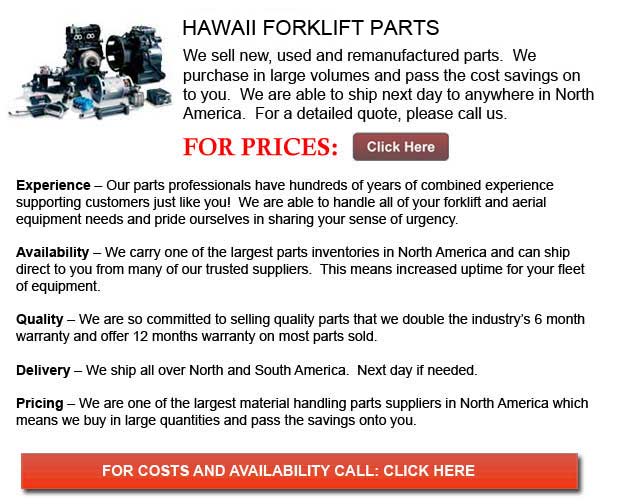
Hawaii Forklift Parts - The state of Hawaii is the last state to gain entry into the union on the 21st of August, 1959, and is the only state in the United States which is made up completely of islands. Within Polynesia, Hawaii is the northernmost grouping of islands, an archipelago within the central Pacific Ocean. The continental US is located in the northeast, Japan is to the northwest, and Australia is situated within the southwest. Hawaii's natural and diverse scenery, warm tropical weather, active volcanoes and abundance of public beaches and oceanic surroundings make it a popular location for surfers, tourists, volcanologists and biologists alike. Because of its mid-Pacific site, the state of Hawaii has numerous Asian and North American influences along with its own vibrant native culture. The state of Hawaii has more than a million permanent residents in addition to lots of U.S. military personnel and tourists. Its capital is Honolulu on the island of Oahu.
The state of Hawaii encompasses the majority of the volcanic Hawaiian Island chain, which consists of hundreds of islands spread over 2,400 km or 1,500 miles. The eight "main islands" of Hawaii are situated on the southeastern end of the archipelago. The main islands include Niihau, Kauai, Oahu, Molokai, La-nai, Kahoolawe, Maui, and Hawaii The last is by far the biggest and is commonly called "The Big Island" to avoid confusion with the state as a whole. The archipelago is physiographically and ethnologically part of the Polynesian sub-region of Oceania.
The coastline of Hawaii is about 750 miles or 1,210 km long, that makes it the fourth biggest within the United States behind the states of California, Alaska and Florida.
The history of Hawaii can be traced through a succession of dominant businesses: sandalwood, whaling, pineapple, sugarcane, military, tourism, and education. Ever since statehood during the year 1959, tourism has been the largest industry, contributing 24.3% of the Gross State Product (GSP) during 1997, despite efforts to diversify. The gross output for the state during the year 2003 was US$47 billion; per capita income for the inhabitants of Hawaii was US$30,441.
The exports out of the state of Hawaii include food and apparel. Nevertheless, these industries play only a small part in the economy because of the vast distances to ship to possible markets, like for example the Western Coast of the contiguous US. Food exports include macadamia nuts, coffee, livestock, sugarcane and pineapple.
The state tax burden was fairly high. The inhabitants of Hawaii had the highest state tax per capita of $2,838, during the year 2003. This is partly because education, health care and social services are all directly provided by Hawaii, compared to local government in all other states.
Millions of visitors contribute to the tax take by paying the general excise tax and hotel room tax; thus not all taxes come directly from inhabitants. Business leaders, however, consider the state's tax burden very high, contributing to both higher prices and the perception of an unfriendly business climate.
Lift Parts Express
TOLL FREE: 1-888-695-7994
forkliftpartshawaii.com
Email Us
About Us

